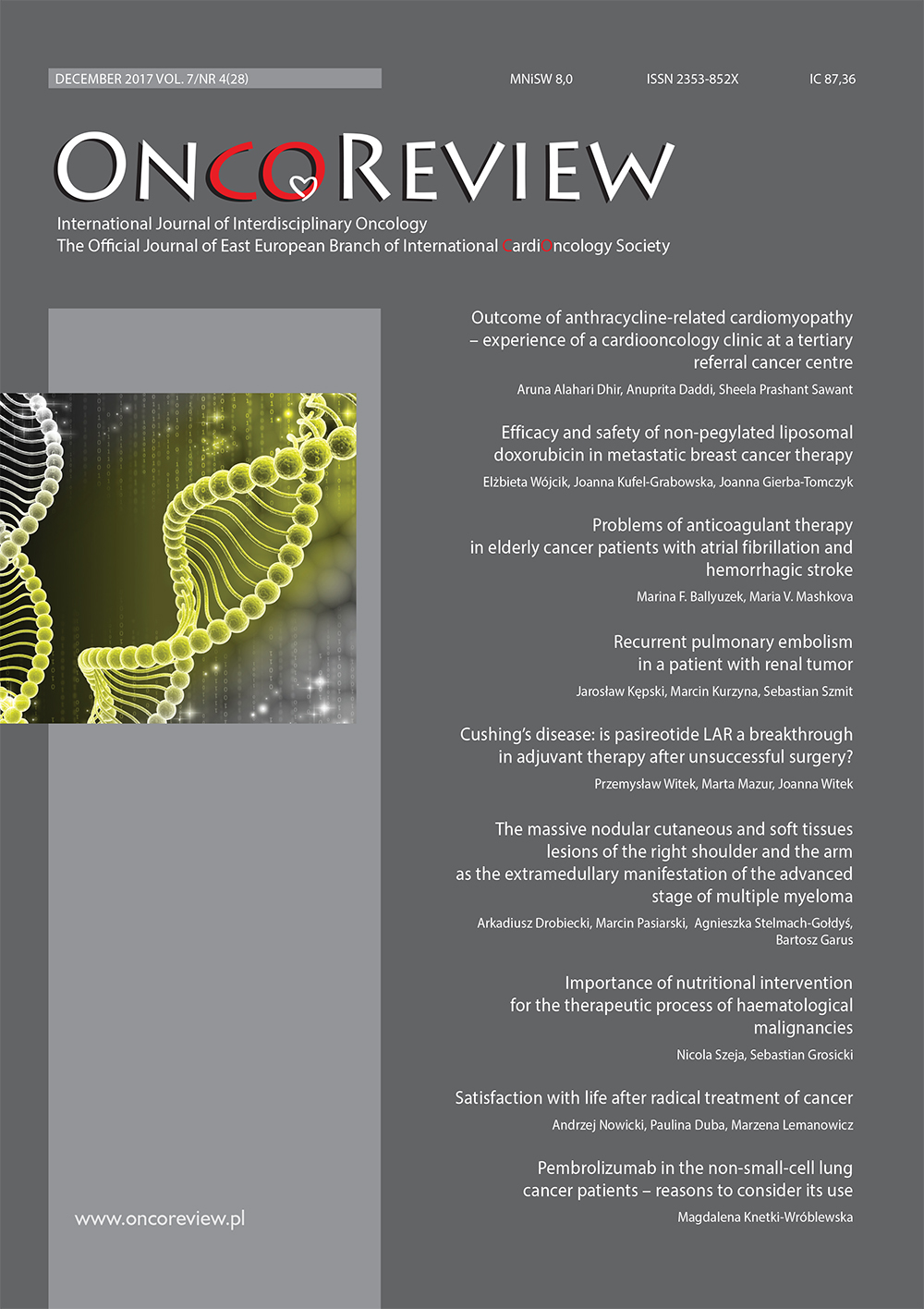Efficacy and safety of non-pegylated liposomal doxorubicin in metastatic breast cancer therapy Case report
Main Article Content
Abstract
Breast cancer is the most frequently diagnosed female cancer in Poland (over 17,500 women). Anthracyclines have become one of the most important drugs in breast cancer systemic treatment. In the treatment of metastatic disease combination chemotherapy with doxorubicin provides the objective response rate of 60–85%, and the median time of progression-free survival is about 12 months. Non-pegylated liposomal doxorubicin (NPLD) in combination with cyclophosphamide is associated with a lower risk of cardiotoxicity, higher efficacy and more favourable toxicity profile as compared with conventional anthracycline regimes. Two cases of females patients treated with NPLD described in this article demonstrate the importance of the choice of chemotherapy, professional monitoring, early detection and treatment of adverse effects. Non-pegylated liposomal doxorubicin ordained in systemic treatment of stage IV breast cancer prolongs survival and enhances the quality of life. It is a reasonable option for palliative therapy.
Downloads
Metrics
Article Details

This work is licensed under a Creative Commons Attribution-NonCommercial 4.0 International License.
Copyright: © Medical Education sp. z o.o. This is an Open Access article distributed under the terms of the Attribution-NonCommercial 4.0 International (CC BY-NC 4.0). License (https://creativecommons.org/licenses/by-nc/4.0/), allowing third parties to copy and redistribute the material in any medium or format and to remix, transform, and build upon the material, provided the original work is properly cited and states its license.
Address reprint requests to: Medical Education, Marcin Kuźma (marcin.kuzma@mededu.pl)
References
2. Pieńkowski T. Rak piersi. W: Krzakowski M. (ed.). Onkologia kliniczna. Borgis Wydawnictwo Medyczne, Warszawa 2006: 1014-1056.
3. Steinherz LJ, Steinherz PG, Tan CT et al. Cardiac toxicity 4 to 20 years after completing anthracyclin therapy. JAMA 1991; 266: 1672-1677.
4. Cardinale D, Colombo A, Lamantia G et al. Anthracyclin-induced cardiomyopathy: clinical relevance and response to pharmacologic therapy. J Am Coll Cardiol 2010; 55(3): 213-220.
5. Yeh ET, Bickfort CL. Cardiovascular complications of cancer therapy: incidence, pathogenesis, diagnosis and managment. J Am Coll Cardiol 2009; 53: 2231-2247. https://doi.org/10.1016/j.jacc.2009.02.050.
6. Green DM, Hyland A, Chung CS et al. Cancer and cardiac mortality among 15 year survivors of cancer diagnosed during childhood or adolescence. J Clin Oncol 1999; 17: 3207-3215.
7. Shan K, Lincoff AM, Young JB. Anthracycline-induced cardiotoxicity. Ann Intern Med 1996; 125: 47-58.
8. Adams MJ, Hardenbergh PH, Constine LS, Lipshultz SE. Radiation associated cardiovascular disease. Crit Rev Oncol Hemat 2003; 45: 55-75.
9. Batist G, Harris L, Azarnia N et al. Improved anti-tumor response rate with decreased cardiotoxicity of non pegylated liposomal doxorubicin compared with conventional doxorubicin in first-line treatment of metastatic breast cancer in patients who had received prior adjuvant doxorubicin: results of a retrospective analysis. Anticancer Drugs 2006; 17(5): 587-595.
10. Stradivardi F, Palmieri C. Efficacy and toxicity of nonpegylated liposomal doxorubicin in breast cancer. Expert Rev Anticancer Ther 2008; 8(12): 1859-1869.
11. Harno CE, Bloom MW, Cardinale D et al. Cancer Therapy-Related Cardiac Dysfunction and Heart Failure. Part 2. Prevention, Treatment Guidelines, and Future Directions. Circ Heart Fail 2016; 9: e002843.
12. Piotrowski G, Gawor R, Gawor Z et al. Obrazowanie serca i naczyń. Kardiol Pol 2014; 72: 558-575.
13. Ammon M, Arenja N, Leibendgut G et al. Cardiovascular management of cancer patients with chemotherapy-associated left ventricular systolic dysfunction in real word clinical practice. J Card Fail 2013; 19: 629-634.
14. Szmit S, Jędrzejczak WW, Opolski G. Consensus statement on indication for the use of non-pegylated liposomal doxorubicin in patients with lymphomas and concomitant cardiovascular diseases. OncoReview 2013; 3: 213-215.
15. Zuppinger C, Timolati F, Suler TM. Pathophysiology and diagnosis of cancer drug induced cardiomyopathy. Cardiovasc Toxicol 2007; 7: 61-66.

